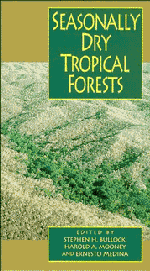Book contents
- Frontmatter
- Contents
- List of contributors
- Acknowledgements
- 1 Introduction
- 2 Dry forests of Central America and the Caribbean
- 3 Overview of the Brazilian caatinga
- 4 Savannas, woodlands and dry forests in Africa
- 5 Dry forest ecosystems of Thailand
- 6 The Cenozoic record of tropical dry forest in northern Latin America and the southern United States
- 7 Diversity and floristic composition of neotropical dry forests
- 8 Vertebrate diversity, ecology and conservation in neotropical dry forests
- 9 Diversity of life forms of higher plants in neotropical dry forests
- 10 Drought responses of neotropical dry forest trees
- 11 Plant reproduction in neotropical dry forests
- 12 Plant–herbivore interactions in Mesoamerican tropical dry forests
- 13 Biomass distribution and primary productivity of tropical dry forests
- 14 Nutrient cycling in tropical deciduous forests
- 15 Biology of the belowground system of tropical dry forests
- 16 Nitrogen trace gas emissions in a tropical dry forest ecosystem
- 17 Conversion of tropical dry forest to pasture and agriculture
- 18 Ethnobotany of the Mexican tropical dry forests
- Index
15 - Biology of the belowground system of tropical dry forests
Published online by Cambridge University Press: 07 September 2010
- Frontmatter
- Contents
- List of contributors
- Acknowledgements
- 1 Introduction
- 2 Dry forests of Central America and the Caribbean
- 3 Overview of the Brazilian caatinga
- 4 Savannas, woodlands and dry forests in Africa
- 5 Dry forest ecosystems of Thailand
- 6 The Cenozoic record of tropical dry forest in northern Latin America and the southern United States
- 7 Diversity and floristic composition of neotropical dry forests
- 8 Vertebrate diversity, ecology and conservation in neotropical dry forests
- 9 Diversity of life forms of higher plants in neotropical dry forests
- 10 Drought responses of neotropical dry forest trees
- 11 Plant reproduction in neotropical dry forests
- 12 Plant–herbivore interactions in Mesoamerican tropical dry forests
- 13 Biomass distribution and primary productivity of tropical dry forests
- 14 Nutrient cycling in tropical deciduous forests
- 15 Biology of the belowground system of tropical dry forests
- 16 Nitrogen trace gas emissions in a tropical dry forest ecosystem
- 17 Conversion of tropical dry forest to pasture and agriculture
- 18 Ethnobotany of the Mexican tropical dry forests
- Index
Summary
Introduction
Tropical forests have received considerable attention recently, stimulated in part by the high rate at which they are being modified or completely destroyed. Emphasis has been given to their potential effect on the global carbon balance and on biogenic emissions (García-Méndez et al., 1991; Matson & Vitousek, Chapter 16). Most studies have focused on tropical forests growing in wet or humid climates which account for 58% of tropical forests (Brown & Lugo, 1982), while seasonal forests growing in drier climates, which represent the remaining 42%, have been very little studied (Murphy & Lugo, 1986a). Tropical dry forests represented nearly 20% of the total biomass of forests in the world in the early 1970s (Persson, 1974). But due to deforestation, and extensive use of the area for intensive agriculture, pastures and shifting cultivation among other uses, the present area is considerably reduced.
Constraints on soil biological activity and their effect on ecosystem production, soil organic matter formation and nutrient cycling have been little studied in dry forests (Anderson & Flannagan, 1989). Most of the work on this topic has been carried out in India with considerably less information available from dry forests of the neotropics.
In this review I will discuss how water availability primarily constrains soil biological activity in tropical dry forests, in order to highlight its importance in the dynamics of organic matter and nutrients in the ecosystem.
Climatic characteristics of tropical dry forests
Strong rainfall seasonality is the overriding macro-determinant in dry forests. Seasonality and, most important, the duration and intensity of dry and wet periods, exert a strong influence on the biological activity of both the above- and below-ground parts of the ecosystem.
- Type
- Chapter
- Information
- Seasonally Dry Tropical Forests , pp. 362 - 383Publisher: Cambridge University PressPrint publication year: 1995
- 13
- Cited by



